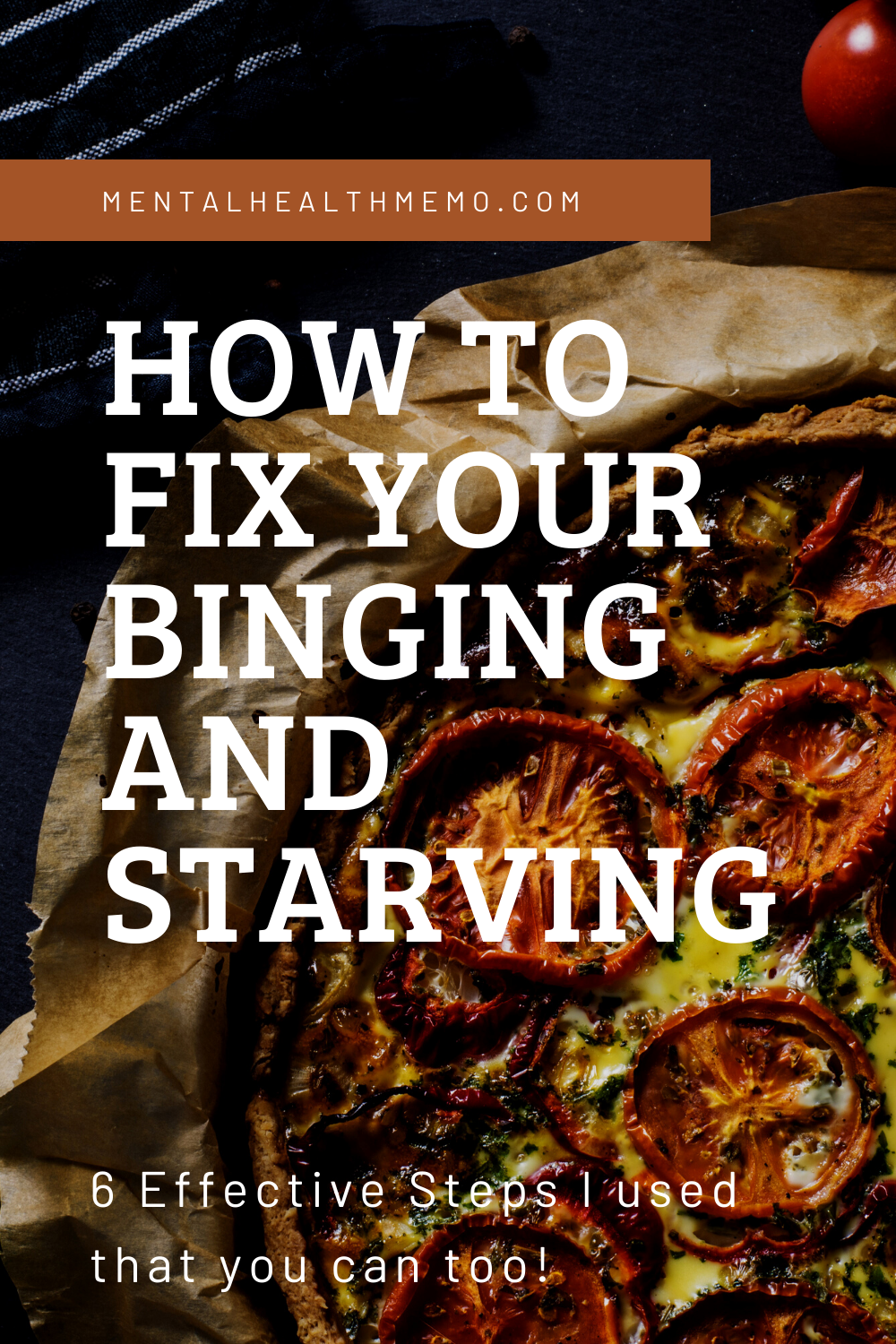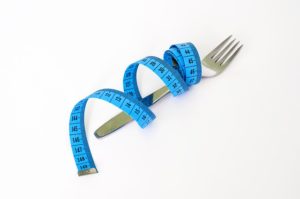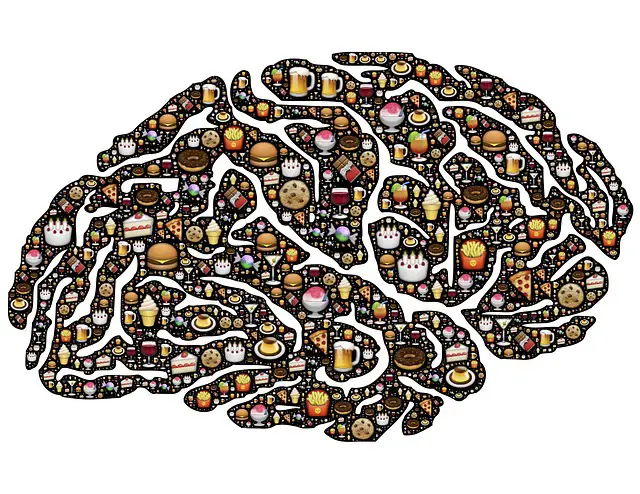What is Binging and Starving?
Binging is the act of eating at in access to a point of discomfort, and most often people binge on unhealthy foods.
Starving is the act of refraining from eating, typically with the intent of losing weight or not gaining weight.
Each of these eating behaviors can morph into their own eating disorder, Binge Eating Disorder, and Anorexia Nervosa respectfully.
However, another form of disordered eating is both binging and starving.
Often times, an individual might feel emotionally overwhelmed and resort to binging as a coping mechanism as it comforts them. They will likely then feel so guilty about the binging, that they will starve themselves to “reverse” the calories (I put reverse in quotation marks because that’s not how it works!).
While this tends to be the typical pattern, it is by no means what everyone experiences. Some people may binge and starve as a sense of control, self-harm, or some other variant.
Additionally, someone may binge and choose to purge, exercise or take laxatives instead of starving, or use a mix of starving with one of these components.
Nobody experiences disordered eating in the same way, so it’s important to keep that in mind as you read this article.

My Story with Starving and Binging
I have always had a really bad relationship with food and my body image. This has led me to a terrible habit of binging and starving since my tween years. My weight fluctuates easily, so I would find myself looking large one month then skinny the next.
With social media, ads, societal expectations, and comments about my weight from others, I started to become hyper-aware of how I looked. Seeing pictures of tall, skinny women made me feel unworthy and ugly.
This is not a unique experience. I don’t think I have yet to meet a person who has not been affected by pressures to be skinny (men included).
There is a drive for change now, and for the inclusiveness of varying body shapes in media. But there is still a lot of work to be done.
However, that didn’t stop me from my binging and starving habit.
And it often varies in its presence.
Sometimes I’ll starve for months, and then binge every meal for weeks. Other times I’ll eat nothing all day and come home to inhale everything in the fridge as if I’m Kirby. Or I’ll eat a lot one day, then nothing the next. Basically my eating habits were a big ol’ MESS.
I felt gross whenever I would binge, and exhausted when I would starve. Neither option was working out well for me.
What made it worse was my low self-esteem and twisted relationship with my body. I liked starving because it meant I would be skinnier. I would push myself to do it and to excessively exercise. And I’d be proud of it! That’s messed up.
My body was also suffering from all the changes in eating. My stomach was in constant pain, I barely slept, I had no energy or strength, and my moods got out of hand.
Food acted as both my cure and my pain.
I knew this was not healthy, but felt too burned out to fix it. But in a last-ditch effort (mostly because my stomach was in so much pain), I decided to give change one more go.
And this time, it was successful.
In this article, I’m going to tell you exactly what I did to help fix my binging and starving when nothing else had worked before. Let’s start!
1. Understanding That Starvation = Weight Gain Not Weight Loss
What I want to note is that I still have thoughts of being too large. The negative mindset of wanting to starve to be skinny is still present. So instead of trying to completely destroy that mindset, I decided to work with it.
What I mean by that is my end goal was wanting to be skinny, which is why I starved. The scientific reality though is that when you starve for a long time then start eating again, you gain twice the weight back. This has held true for me every single time I was starving and binging.
So if I wanted to actually lose weight and keep it off, I had to eat. If I starved, I’d just gain way more weight back.
This in a way canceled out the desire to starve via logic. I want to be skinny? I have to not starve. If I starve, I gain weight. I don’t want to gain weight.
Get what I mean?
It’s a bit messed up because it feeds into the fear of gaining weight, but it works to keep me from starving. And honestly, that’s good enough for me right now. I’m still slowly working on changing my mindset that large = bad. But until that sinks in, this works.
2. Add Instead of Taking Away
I was stuck in the mentality that eating less and taking ingredients away is going to help me to lose weight. But it doesn’t!
If I wanted to be healthy and lose weight for the long-term, I had to make sure I was eating nutrient-dense meals. That means adding anything I could possibly think of to create a richer nutritional profile.
By doing this, my stomach got better, I had more energy, I felt better overall, and my relationship with food improved drastically. I didn’t feel that same desire of binging and starving once I was eating wholesome foods that made me feel so good.
I did this slowly and gradually, as I learned more and more about healthy foods and my body.
I started first with seeds, nuts, and powders since those are very easy to incorporate. For example, I started adding a quality protein powder to smoothies since I
don’t get a lot of it in my regular meals. I also added seeds and nuts to stir frys, salads, power bowls, and other foods I was eating.
Then I started incorporating other things like beans, greens, and legumes into meals I was already making to give them extra nutritional value.
Now whenever I’m thinking about what I’m going to eat, I focus on what I can add so I can get the maximum amount of nutrition from my meals. This is opposite to what I used to do which was being extremely restrictive.
I’ve found that just because of this switch in my mindset, I eat significantly healthier. My meals are now balanced, and nutrition-packed. And my mind and body are definitely thanking me for it.
I also set myself up for success with this strategy by meal prepping and creating detailed grocery lists. I’ll get to that in the next point.
For now, what’s important to know is that you need to change your mindset from “I need to take everything away” to “What can I add to make this meal even more nutritious?”. Because having a rich and healthy diet is going to help you reach your weight goals much easier than not eating at all.

3. Meal Prepping & Grocery Lists
These 2 things are going to make your life so much easier. Even 1 hour of meal prep and 10 minutes for writing a grocery list are substantial.
Meal Prepping:
Batch making a few things during the week can make it really easy to throw together a quick, healthy meal.
I always do homemade hummus since I eat a lot of wraps, quinoa for fast power bowls, tofu for anything really, boiled eggs for breakfasts, and sauces for stir frys, salads, and power bowls.
Just those 5 things alone save me so much energy and time during the rest of the week and take me under an hour to make.
Groceries:
The reason I only have to prep 5 things is I buy ingredients that are very easy and quick to throw into anything. Some staples I always have are:
- Spinach (put it in a wrap, a power bowl, a smoothie, or a curry)
- Avocado
- Hemp & sesame seeds for garnishing
- Frozen edamame (can be eaten raw in a power bowl or cooked with stir fry)
- Frozen berries for smoothies
- Frozen veggies for quick meals (there’s nothing wrong with frozen food y’all. Better than no veggies at all!)
- Soba noodles (they cook really quickly and are a healthier alternative to bleached noodles)
- Coconut milk (for quick curries **especially if you have curry paste**)
So let’s say I’m really not in the mood to cook and I’m hungry. No prob! I can make myself a wrap or sandwich with the homemade hummus, avocado, spinach,
and maybe some sliced meats and cheese if I have any.
Or I could take my quinoa and add some edamame, tofu, spinach, avocado and seeds to it with some sauce.
Maybe for a snack, I can just chuck some frozen fruit in the blender with water or almond milk and call it a day. Potentially I could use the soba noodles and frozen veggies to make a quick stir fry with tofu.
The options are limitless! And it’s SO easy.
So think about what you like to eat and what works with your lifestyle. Then make a grocery and meal prep routine that serves you.
Obviously, mine is just an example and would likely not work for someone else who is a huge meat eater (I’m not). So maybe meal prepping some meat would be part of that person’s plan.
Try it out, make mistakes, then learn from them and improve. I got this stuff down after a lot of experimenting and adjustment.
But it makes eating healthier, more nutritionally dense meals so much easier because the ingredients are already there. All you have to do is add them together. This really helps prevent me from starting up my binging and starving habits again.
And if you have food that isn’t as healthy, you can use healthy ingredients to enhance the meal.
For example, chucking some spinach onto your pizza. Or sprinkling some seeds in your yummy sugary cereal. Maybe adding some frozen fruit to your brownies.
Incorporating good food doesn’t have to be super hard and yucky. Start little by little!
4. Getting Re-familiarized with Hunger and Fullness Cues (Dietitian Tip)
Because of all the pain in my stomach and my terrible habits of starving and binging, I took the step to go see a dietitian.
Since I either completely neglected my hunger cues or would override my fullness cues, I had a really hard identifying what my stomach was saying. So my dietitian recommended we start at the beginning. Re-familiarizing myself with my hunger and fullness cues.
She gave me a scale that ranged from “completely stuffed” to “absolutely famished”. I had to keep that chart with me throughout the day so that I could get in touch again with the cues I had lost.
And it really helped!
I stopped overeating by using the prompts of the chart as I ate so that I could pinpoint when I felt comfortably full. When I got there, I would stop eating.
This bit was really hard because I was so used to being in the “completely stuffed” range. But my dietitian said that I can always go back and eat more if I’m still hungry, so it’s better to stop and wait than regret being really full.
Whenever I felt any bit of hunger, I’d do the same thing and decide if I was actually hungry or potentially just bored or thirsty.
Doing this got me back in tune with my body, and made me better at listening to what it wants. And then actually giving it what it said it needs.

5. Identifying Triggers
To fix a bad eating habit, you first need to figure out why you do it in the first place.
A lot of times stress and sadness can play a big role in what you eat. How many times have you had a terrible day at work and your way of de-stressing was eating a bag of chips?
Do you feel like making a good meal when you’re sad or do you just want to reach for that instant ramen because you’re too depressed to care?
Or going the opposite direction, maybe you starve and try to eat really good right before a certain event where you have to look good.
We all have triggers that affect our eating behavior.
For me, triggers very easily kick-started my binging and starving.
When I’m stressed about things like school, work, or finances, I tend to binge on bad food.
If I’m really anxious, or depressed, I tend to not eat at all.
So figuring out what my triggers were helped me better prepare for the reactions they induced. And the way I do this is going to be explained in the following point!
6. Preparing For a Potential Binge or Starvation Session
As just mentioned, if you know your triggers, you can prepare for them. I do this in 2 ways.
First, I make sure I have appropriate food for the occasion.
Since I binge if stressed, I make sure not to buy junk food and instead opt for healthier snacks that are always on hand. That tends to be dark chocolate, rice cakes, and varying types of nuts for me.
So when I come home and want to nibble my stress away, I always have something available that’s going to be a healthier option than just regular chips or chocolate.
If I’m tempted to starve or I don’t have an appetite, I make sure to always have foods that are easy to eat at my disposal. Fruit yogourts, berries, smoothie ingredients, rice cakes, and more. Basically, anything that’s not going to require a lot of work or chewing.
This makes the challenge of eating a bit easier since I’m not having anything big. Just something small and easy to eat.
The second thing I do is I try to exert that negative energy in a more positive way.
So instead of binging, I relieve my stress by exercising (I’ve already written an article about how important exercise is for mental health), reading, writing in my journal, painting, going for a walk, or anything else like that.
When I can’t eat, I do the same thing.
This helps me release those gross emotions and makes me feel less prone to exhibiting bad eating behaviors.
Also, those activities tend to make me hungry. This makes it easier to eat when I’m struggling to do so, and it forces me to eat a bigger meal when binging which stops me from snacking.
An overall win-win!

Final Thoughts
Binging and starving is a really nasty cycle that can really ruin your quality of life. It definitely damaged my self-esteem and my body. I hope my tips have helped to inspire you, and guide you in the right direction.
Take care of your body, you only have one.
All my love,
T

